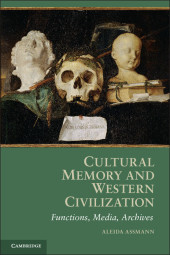
Cultural Memory and Western Civilization - Functions, Media, Archives
| Verlag | Cambridge University Press |
| Auflage | 2011 |
| Seiten | 406 |
| Format | 22,8 cm |
| Gewicht | 576 g |
| Artikeltyp | Englisches Buch |
| ISBN-10 | 0521165873 |
| EAN | 9780521165877 |
| Bestell-Nr | 52116587EA |
This book provides an introduction to the concept of cultural memory, offering a comprehensive overview of its history, forms and functions.
Klappentext:
This book provides an introduction to the concept of cultural memory, focusing on the 'arts' of its construction, particularly various media such as writing, images, bodily practices, places and monuments. The analysis also addresses the interaction of cultural memory with individual memory and the ways in which cultural memory supports or subverts social and political identity constructions. Cultures invest great efforts into creating a long-term memory on the basis of oral transmission, media technology and institutional frameworks. This book provides an introduction to the concept of cultural memory, focusing on the 'arts' of its construction, particularly various media such as writing, images, bodily practices, places and monuments. Examining the period from the European Renaissance to the present, Aleida Assmann reveals the close association between cultural memory and the arts, arguing that the artists who have supplemented, criticized, transformed and opposed it are its most lucid theorists and acute observers. Her analysis also addresses the interaction of cultural memory with individual memory and the ways in which cultural memory supports or subverts social and political identity constructions. Ultimately, this book offers a comprehensive overview of the history, forms and functions of cultural memory, which has become a central analytical tool for scholars across disciplines.
Inhaltsverzeichnis:
Introduction; Part I. Functions: 1. Memory as ars and vis; 2. THE sECULARIZATION oF mEMORY MEMORIA, FAMA, HISTORIA; 3. The battle of memories in Shakespeare's histories; 4. Wordsworth and the wound of time; 5. Memory boxes; 6. Function and storage: two modes of memory; Part II. Media: 7. Metaphors, models, and media of memory; 8. Writing; 9. Image; 10. Body; 11. Places; Part III. Storage: 12. Archives; 13. Permanence, decay, residue problems of conversation and the ecology of culture; 14. Memory simulations in the wasteland of forgetfulness installations by modern artists; 15. Memory as 'leidschatz'; 16. Beyond the archive; 17. Conclusion: the arts of memory.
